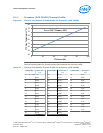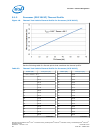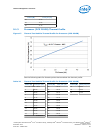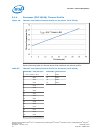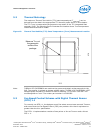
5.0 Thermal Management
This chapter provides both component-level and system-level thermal management.
Topics covered include processor thermal specifications, thermal profiles, thermal
metrology, fan speed control, adaptive thermal monitor, THERMTRIP# signal, Digital
Thermal Sensor (DTS), Intel Turbo Boost Technology, package power control, power
plane control, and turbo time parameter.
The processor requires a thermal solution to maintain temperatures within its
operating limits. Any attempt to operate the processor outside these operating limits
may result in permanent damage to the processor and potentially other components
within the system. Maintaining the proper thermal environment is key to reliable,
long-term system operation.
A complete solution includes both component and system level thermal management
features. Component level thermal solutions can include active or passive heatsinks
attached to the processor integrated heat spreader (IHS).
To allow the optimal operation and long-term reliability of Intel processor-based
systems, the processor must remain within the minimum and maximum case
temperature (T
CASE
) specifications as defined by the applicable thermal profile.
Thermal solutions not designed to provide this level of thermal capability may affect
the long-term reliability of the processor and system.
The processors implement a methodology for managing processor temperatures that
is intended to support acoustic noise reduction through fan speed control and to
assure processor reliability. Selection of the appropriate fan speed is based on the
relative temperature data reported by the processor’s Digital Temperature Sensor
(DTS). The DTS can be read using the Platform Environment Control Interface (PECI)
as described in Processor Temperature on page 74. Alternatively, when PECI is
monitored by the PCH, the processor temperature can be read from the PCH using the
SMBus protocol defined in Embedded Controller Support Provided by the PCH. The
temperature reported over PECI is always a negative value and represents a delta
below the onset of thermal control circuit (TCC) activation, as indicated by PROCHOT#
(see Processor Temperature on page 74). Systems that implement fan speed control
must be designed to use this data. Systems that do not alter the fan speed only need
to ensure the case temperature meets the thermal profile specifications.
Analysis indicates that real applications are unlikely to cause the processor to
consume maximum power dissipation for sustained time periods. Intel recommends
that complete thermal solution designs target the Thermal Design Power (TDP),
instead of the maximum processor power consumption. The Adaptive Thermal Monitor
feature is intended to help protect the processor in the event that an application
exceeds the TDP recommendation for a sustained time period. For more details on this
feature, see Adaptive Thermal Monitor on page 75. To ensure maximum flexibility
for future processors, systems should be designed to the Thermal Solution Capability
guidelines, even if a processor with lower power dissipation is currently planned.
Thermal Management—Processor
Desktop 4th Generation Intel
®
Core
™
Processor Family, Desktop Intel
®
Pentium
®
Processor Family, and Desktop Intel
®
Celeron
®
Processor Family
December 2013 Datasheet – Volume 1 of 2
Order No.: 328897-004 65













